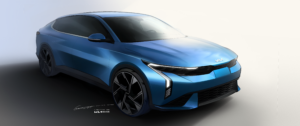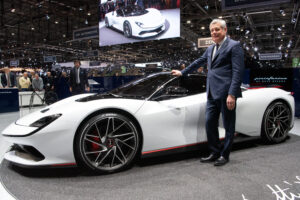2010 LINCOLN MKT and C CONCEPT: BIG LUXURY IN SMALL PACKAGE
DETROIT, Jan. 12, 2009 – Lincoln is breaking new ground with the Lincoln C concept, a new big idea for a small luxury car. Designed with today’s upscale, urban consumer in mind, the Lincoln C concept brings the presence and elegance of a large Lincoln to a smaller, more efficient C-sized car. “Modern luxury buyers who live and work in large, urban areas want to play their part in helping the environment by moving to a smaller vehicle, but they still want to enjoy the luxuries of life,†said Peter Horbury, executive director of Design, The Americas. “The Lincoln C offers sensible indulgence.â€
According to Horbury, younger contemporary consumers with slim iPods and pocket-sized cameras have already grown accustomed to the notion of premium quality in a small package. “During the past decade, people have gotten used to the idea that you could pay more money for a smaller version of the real thing,†said Horbury, citing the evolution of music players from tapes to CDs to MP3 players as an example. “The same philosophy can be applied to the automobile,†he added. “People will be happy to buy a smaller car that is better for the environment and more maneuverable in the city as long as the vehicle has all the attributes they want.â€
The concept’s unique size, lightweight construction and use of sustainable materials make the Lincoln C stand out – along with its fuel economy.
Featuring a 1.6-liter EcoBoost engine and Ford’s all-new dry, dual-clutch PowerShift six-speed transmission, the Lincoln C concept achieves 43 mpg on the highway, while offering up an impressive 180 horsepower and 180 ft.-lbs. of torque. PowerShift and outstanding driving dynamics make the Lincoln C concept fun for the driver.
Plus, a sophisticated human machine interface (HMI) and forward-thinking in-car connectivity technologies bring a whole new dimension to social networking, an important facet of modern customers’ active lifestyles.
“Connectivity is as much a luxury for today’s younger car buyer as are the traditional luxuries of wood, leather and a comfortable ride,†said Horbury. “It means being able to continue your lifestyle seamlessly while you’re on the move.â€
Sporty, Elegant Exterior Design
When designers developed the Lincoln C concept, their goal was to create a C-sized automobile with both presence and elegance. Their vision: a smaller, more fuel-efficient car that could maneuver easily in congested urban areas and compact parking spaces, yet still provide driver and passengers with levels of luxury and comfort usually reserved for larger sedans.
“Lincoln C is about efficiency without compromise,†said Freeman Thomas, director of Ford’s Strategic Concepts Group, who led the Lincoln C design team – David Woodhouse, Jeremy Leng, Andrei Markevich and Matt Edwards.
One of the most distinctive features of the Lincoln C is its unique silhouette. The visual mass of the car is very low to the road. A low-slung shoulder line with a wheel-at-each-corner stance supports a dynamic, slightly formal cabin. The aim was “go kart†visual stability combined with elegant lines and surfaces.
At first glance, the silhouette is immediately distinguished by a bold front profile, low shoulder, high beltline, wide C-pillar and compact bustle back.
The modern appearance of the Lincoln C reflects the timeless, iconic elements of the Lincoln DNA: sheer surfaces bounded by defined creases; a cantilevered roof extending from a strong C-pillar; a confident double-wing chrome grille; full-width tail lamps and rocker brightwork.
The front end of the concept is unmistakably Lincoln. The signature grille encapsulates LED headlamps that – like the taillights – are made with prismatic optical elements that create depth and visual sophistication. A sculpted groove in the top of the front hood – which derives its shape from the Lincoln badge – adds a finishing touch to the grille of the car.
A low shoulder line combines with a strong, high belt line to create a sense of safety and privacy inside and outside of the vehicle.
An aluminum cantrail adds elegance to the concept by extending the beltline to the rear glass and breaking up the otherwise tall C-pillar. Aluminum is also visible inside the door apertures.
The Lincoln C is absent of a B-pillar or center post. The center-opening doors – a classic Lincoln trait that rekindles memories of the 1961 Continental – allow effortless access to first- and second-row bench seats and give the vehicle a limousine-like quality.
Sleek side mirrors house both advanced rear-view camera and blind spot detection technologies. Slit-like LED turn signal indicators are integrated into the mirrors, allowing slim, efficient light.
LED taillamps span the full-width of the Lincoln C’s rear, featuring turn signal indicators that fade toward the center of the car stretch from side to side.
An all-glass roof provides a modern, futuristic look. The expansive opening illuminates the cabin and enhances the sense of spaciousness inside the car.
Designers reinterpreted the presentation of the Lincoln badge throughout the exterior of the Lincoln C in a subtle way, giving it a contemporary “race track†theme. The Lincoln star sits proudly at the center of the front end, and the rear badge is slightly morphed to suit its placement above the taillights.
A more in-depth look at various details of the Lincoln C reveals that the badge motif is repeated in discreet ways in the design of the front lower intake mesh; the shape of the glass roof and structure; the implied illuminated keyholes on the door handles; the shape of the rear-view camera that sits on the back of the roof; the design of the wheels and the pattern in the tire treads.
The exterior of the Lincoln C is bathed in a light, exterior clear coat that hints of yellow metallic.
Modern, Timeless Interior Design
Inside, the Lincoln C concept welcomes driver and passengers to a space that looks more like the living room of a contemporary urban loft than the inside of a car.
Elements of classic Lincoln DNA permeate the cabin, including: a bright, clean, light color palette; authentic materials such as wood and metal; ambient lighting; jewel-like chrome details; bench seating; and the symmetrical design of the instrument panel, which thoughtfully serves both driver and passengers.
The interior’s all-white color palette — from roof to seats to floor — is stunning. Subtle chrome accents on the seats, instrument panel, door panels and floor glimmer like fine jewelry. A light gray wood veneer – made from recycled wood – provides a striking contrast against the white leather on the instrument panel and door panels. The headliner is white Alcantara suede.
Because the Lincoln C concept is two inches wider than conventional C-class vehicles, it offers the roominess of a 1961 Continental at almost half the length. In modern terms, the vehicle has the overall length of a Ford Focus and the overall width of a Lincoln MKZ.
Designers took full advantage of the extra space in the interior of the Lincoln C by incorporating luxurious bench seating in the front and back rows. They are crafted from luxurious, chromium-free leather and filled with soy foam. The seats are thin and lightweight, but because they were designed to an ergonomic comfort curve, they are extremely comfortable.
There is a single headrest on the left and a double headrest on the right for passengers in both rows. All the headrests automatically retract without occupants for optimized driver vision. Convenience trays are housed compactly behind the front bench. In the closed position, they are flush with the leather and feature chrome release handles.
One of the most eye-catching elements of the seating is the laser-engraved floral etching on the passenger side seats and floor and on the back of the driver’s seat. It is a light, airy pattern that gives the interior a refined, sophisticated look.
Because of their unique shape and the imperceptible way that they are mounted to the floor, the benches appear to be floating inside the cabin.
The steering wheel and instrument panel also seem to be suspended in air. All of these elements combine to enhance the concept’s futuristic look, openness, and give the impression of dynamic space within the vehicle.
The steering wheel is hubless, lending the driver an unobstructed view of the instrument panel. The glossy white rim rotates around a stationary chrome ring with chrome shifter paddles on both sides. Simple toggles embedded into the left and right sides of the wheel control the vehicle’s navigation system and menu selection.
The instrument panel is leather-wrapped with a chrome bezel. The light, gray wood veneer forms a symmetrical shape that surrounds the center-mounted touch screen and extends out to the right and left sides. Above the center screen is the Lincoln nomenclature and badge, finished tastefully in chrome.
The panoramic instrument panel is divided into three sections and designed with a mixture of digital and analog components. The left side contains Lincoln’s signature HMI menus and driver-related information. The center portion displays a multi-functional screen displaying navigation, SYNC details and a life-like custom avatar to help make everyday journeys more seamless and other helpful, driver-oriented options.
Soft, white ambient lighting creates a relaxing atmosphere inside the cabin. The lighting is integrated into the C-pillar with a front face that displays the Lincoln badge.
The roof also features an integrated rearview mirror and a chrome-trimmed Web camera that rotates to the right or left, depending on whether the driver or the passenger is communicating via the Internet. A chrome air vent follows the shape of the glass roof.
“While the most luxurious and indulgent products often come in the smallest packages, unfortunately this hasn’t been true of most small cars recently,†said J Mays, Ford’s group vice president of Design. “With the Lincoln C, we’ve remixed the traditional small car formula, taking the most engaging technologies and wrapping them in a design fit for today’s urban luxury customer – without sacrificing style or substance.â€





